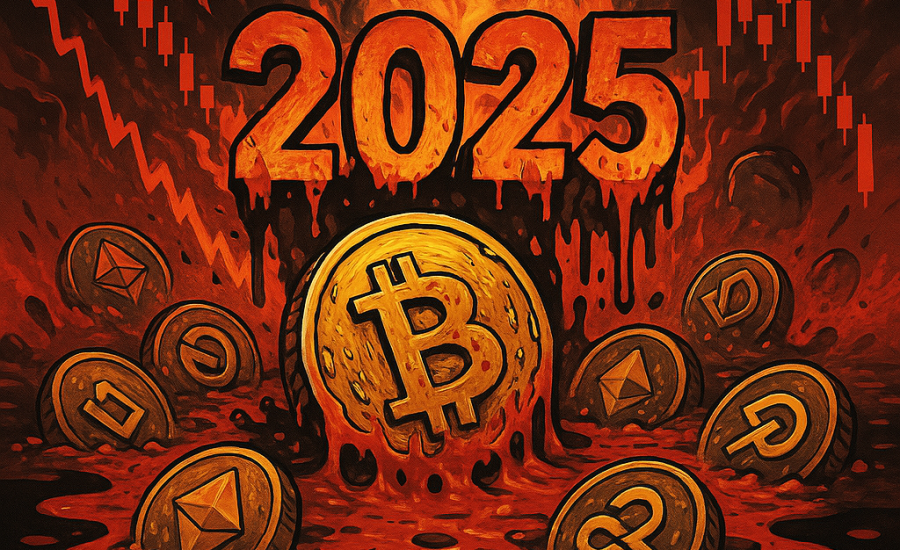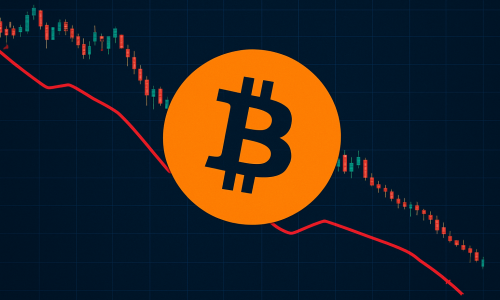Introduction
In early April 2025, the crypto market was rocked by a dramatic and sudden collapse that erased over $1.76 billion in open interest and liquidated millions of leveraged positions across major exchanges. The fallout was swift and unforgiving — a broad sell-off that wiped out gains built painstakingly over months. This was not merely a correction; it was a violent shakeout that echoed throughout the digital asset ecosystem.
Bitcoin, which had maintained relatively stable momentum in recent weeks, plunged sharply below the psychological $100,000 level, dragging altcoins into a red sea of panic. Ethereum followed suit, while leading altcoins such as Solana (SOL), Cardano (ADA), Avalanche (AVAX), and meme coins like Dogecoin (DOGE) saw double-digit losses. The Fear & Greed Index collapsed to its lowest point in nearly a year, underscoring a shift from cautious optimism to full-blown panic.
The Trigger: What Sparked $1.76 Billion In Liquidations?
At the heart of the April 3 event was a massive liquidation cascade — a chain reaction that resulted in over $1.76 billion being wiped out across centralized and decentralized trading platforms. This liquidation wave was primarily driven by overleveraged positions across Bitcoin, Ethereum, and altcoins.
High leverage has long been a double-edged sword in crypto trading. While it allows traders to amplify gains, it also creates a tightly wound structure vulnerable to rapid collapse. With BTC flirting around key resistance levels and altcoins showing signs of exhaustion, it took only a small price drop to initiate stop-loss triggers and margin calls. What began as a modest selloff quickly turned into a snowballing liquidation event.
Exchanges like Binance, Bybit, and OKX reported massive spikes in auto-liquidations, while decentralized protocols such as dYdX and GMX struggled to handle the volume. The problem was compounded by thin liquidity books and panic-induced market orders, which accelerated the downward momentum. Once BTC fell below $95,000, a cascade of liquidations in Ethereum and altcoins pushed the market into freefall.
Binance In The Crosshairs: Market Structure Or Manipulation?
Binance, the world’s largest crypto exchange, once again found itself in the middle of controversy during the crash. Several on-chain analysts and crypto sleuths pointed out irregular activity patterns just hours before the sharp drop. Automated trading bots reportedly executed high-frequency sell orders that intensified the velocity of the plunge.
In a separate report published by Coinspeaker, suspicions were raised regarding the possibility of market manipulation — or at the very least, a failure of Binance’s risk engine to slow the volatility. Critics argue that such centralized platforms have too much influence over liquidity flows and can inadvertently (or otherwise) accelerate panic in the market.
Wintermute, a known institutional market maker, was also linked to some of the sudden liquidity withdrawals seen on April 2 and 3. While the full extent of their involvement remains unclear, the event raises broader questions about transparency and systemic risk within the crypto exchange ecosystem.
Macro Stressors: Trump Tariffs And The Fed Shock
While liquidation events are technical in nature, they are often influenced by the broader economic environment — and this was no exception.
On April 1, just days before the crash, the U.S. Federal Reserve issued a surprise policy update suggesting that interest rate hikes might resume if inflation does not ease by mid-year. This unexpected shift sent bond yields soaring and spooked risk markets, including crypto. The Fed’s hawkish tone triggered early selling among institutions, weakening the market ahead of the liquidation wave.
Adding fuel to the fire, former President Donald Trump, currently leading in polls for the 2026 election cycle, proposed a renewed round of tariffs on Chinese technology imports. This stirred geopolitical uncertainty, prompting capital flight from speculative assets. The crypto market, which had been riding a fragile wave of retail optimism, could not absorb the combined shock of institutional outflows and retail panic.
Altcoins Hit Hardest: SOL, ADA, AVAX, And The Meme Coin Wipeout
Although Bitcoin absorbed much of the media focus, the real damage was done in the altcoin segment. Coins like Solana, Avalanche, Cardano, and Polygon witnessed 20% to 40% drawdowns within 48 hours.
Solana, once hailed as a high-speed Ethereum competitor, dropped below $120, its lowest level in over three months. Avalanche and Cardano saw even deeper losses as liquidity dried up and traders scrambled to exit. Meme coins, which had been enjoying a speculative rally in Q1 of 2025, experienced complete breakdowns — Dogecoin and Shiba Inu both fell more than 30% in a single session.
The root of this vulnerability was a combination of high retail leverage, thin market depth, and overhyped narratives. Many altcoins had been priced for perfection, and when reality came knocking, the correction was merciless.
DeFi And Liquid Staking Tokens Join The Crash
Not to be left behind, decentralized finance (DeFi) tokens and liquid staking protocols like Lido DAO (LDO), Rocket Pool (RPL), and Aave (AAVE) also experienced a brutal drawdown. Many of these protocols rely on TVL (Total Value Locked) and user liquidity, both of which evaporated as ETH prices fell and users withdrew funds en masse.
Liquid staking, which had been touted as the next big innovation in crypto yield strategies, faced a moment of reckoning. As Ethereum dropped and staking rewards failed to offset losses, protocols like Lido saw billions in outflows. The DeFi space, once considered resilient, proved to be just as fragile as the rest of the altcoin market.
Investor Sentiment: From Euphoria To Extreme Fear
Market sentiment flipped dramatically in the wake of the crash. The widely-followed Fear & Greed Index collapsed from 62 (greed) to 19 (extreme fear) within just 72 hours. Social media platforms were flooded with screenshots of liquidated accounts, margin call notifications, and calls for regulatory oversight.
Crypto Twitter, once buzzing with bullish takes and AI-generated moon memes, turned into a space of grief and self-reflection. Influencers who had promoted highly speculative altcoins faced backlash, while respected analysts urged followers to rethink their risk exposure.
Reddit forums like r/CryptoCurrency and r/Bitcoin saw record traffic as confused retail investors sought explanations and reassurance. Some users described losses as high as 90% of their portfolios — a chilling reminder of the risk embedded in unregulated digital markets.
Chain Reactions In CeFi And DeFi Lending
One of the most alarming consequences of the crash was the systemic stress introduced into centralized and decentralized lending protocols. CeFi platforms such as Nexo, BlockFi (in its restructured form), and Matrixport reported liquidity issues as users rushed to withdraw funds.
DeFi protocols like Compound and Aave saw aggressive liquidations as collateral thresholds were breached. Stablecoins like USDT and USDC briefly depegged by 1–2% due to panic selling, although they eventually recovered. The event served as a brutal stress test for the entire decentralized finance architecture, revealing significant weaknesses in the way lending markets handle volatility.
Technical Breakdown: The Role Of Support Levels And Leverage Traps
From a technical analysis standpoint, the April 3 crash confirmed several bearish indicators that had been forming since late March. Bitcoin had been testing resistance near $107,000 but failed to break through multiple times. Meanwhile, RSI (Relative Strength Index) levels were declining across major tokens, suggesting weakening momentum.
Altcoins were particularly vulnerable due to negative divergence and thinning volume. As stop losses triggered, the domino effect kicked in, forcing traders to exit rapidly and intensifying downward pressure. Analysts now estimate that up to 40% of open leveraged positions on altcoin perpetual contracts were wiped out in under 48 hours.
Institutional Reaction: Hedge Funds And Custodians Exit Positions
Institutional crypto exposure has grown steadily over the past two years, with hedge funds, ETFs, and corporate treasuries all entering the space. However, many of these entities operate on strict risk controls — and the April crash triggered automatic liquidation protocols across custodial accounts.
Reports suggest that several funds reduced exposure to Bitcoin by up to 25% in a matter of hours, moving capital to cash or bonds. The SPDR Bitcoin ETF saw record outflows, while custody providers like Fidelity Digital and Anchorage reported elevated redemption volumes.
While long-term institutional confidence in crypto remains intact, the events of April 3 highlighted just how quickly institutions can exit when volatility spikes.
Global Ripple Effects: Asia And Europe Respond
The crypto market is inherently global, and the liquidation wave rippled through Asia, Europe, and emerging markets. In South Korea, exchanges like Upbit and Bithumb reported temporary outages due to excessive user activity. Japan’s FSA issued a cautionary statement urging traders to maintain lower leverage levels.
In the EU, crypto hedge funds based in Switzerland and Germany reported similar losses, especially those exposed to newer DeFi and AI-tokens. Retail investors across Europe panicked, resulting in high sell volumes on platforms like Bitpanda and eToro.
In the aftermath, several jurisdictions began fast-tracking regulations designed to enforce risk controls, margin caps, and transparency requirements on crypto exchanges.
Recovery In Sight? Cardano Shows Early Signs Of Rebound
Interestingly, amid the chaos, not all was doom and gloom. Cardano (ADA) staged a modest recovery just days after the crash, climbing from a low of $0.41 back above $0.51. Analysts attribute this to both oversold conditions and accumulation by whales, who took advantage of the panic to re-enter positions at discounted prices.
Some DeFi and staking tokens also began stabilizing, suggesting that while the market suffered a deep cut, it wasn’t a mortal wound. Nonetheless, volatility remains high and most experts recommend extreme caution in the near term.
What’s Next: Can The Crypto Market Rebuild?
The April 2025 crash will go down as one of the most significant events in crypto’s history, rivaling past episodes like the May 2021 crash and the FTX collapse. But like every previous downturn, it also presents an opportunity.
Builders and investors alike are being forced to re-evaluate their strategies. Leveraged trading will likely see greater scrutiny, while exchanges may be pushed to implement better safeguards against cascading liquidations. The role of stablecoins and decentralized liquidity provisioning may also be re-examined in light of recent instability.
Despite the carnage, many analysts remain cautiously optimistic. Bitcoin’s fundamentals remain strong, institutional adoption continues to grow, and user interest in blockchain technology is higher than ever.
Conclusion
In the end, the $1.76 billion liquidation event was a painful but necessary reminder of the risks inherent in the crypto space. Markets driven by leverage, hype, and retail frenzy are inherently volatile — and without adequate risk management, even the most promising portfolios can unravel in hours.
The crash of April 2025 exposed cracks in the system, but also opened the door for reform, growth, and a return to fundamentals. As the market rebuilds, those who learn from this moment will be best positioned to survive — and perhaps thrive — in the cycles ahead.



